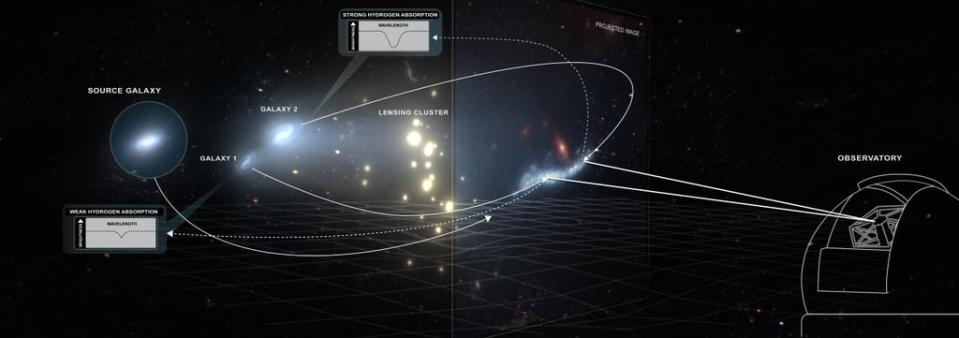Scientists use galaxy as a telescope – and see the beginnings of the universe

Cutting edge instruments and perfect cosmic alignments have allowed astronomers to peer into the nursery rooms of some of the oldest galaxies in the universe.
A new paper published Thursday in the journal Nature describes how scientists used a technique called gravitational lensing and new spectrograph technology to view and characterize massive clouds of gas known as Damped Lyman-α systems, or DLAs, in the early universe.
Scientists believe galaxies and stars slowly condensed out of these huge fields of gas, and the new paper describes two such infant galaxies glowing in their respective nursery clouds some 11 billion years ago.
“The most amazing thing about the DLAs we observed is that they aren’t unique – they seem to have similarities in structure, host galaxies were detected in both, and their masses indicate that they contain enough fuel for the next generation of star formation,” Rongmon Bordoloi, assistant professor of physics at North Carolina State University and one of the paper authors said in a statement.
“With this new technology at our disposal, we are going to be able to dig deeper into how stars formed in the early universe.”
DLAs are vast, tens of thousands of light years across, and don’t emit any light themselves, making it difficult for astronomers to study them. One method is to use the light from Quasars, supermassive black holes with extremely bright optical and ultraviolet light emissions, to illuminate the DLA clouds, but given the clouds’ size, it’s a bit like using a laser pointer to study a fog bank in the dark.
But Dr Bordoloi and his colleagues on the new paper ran into a bit of luck — two DLAs they hoped to study aligned with a cluster of galaxies in the foreground. The massive gravity of the galaxy cluster acts like a lens, bending the light of the galaxies and DLAs, stretching them out and making them appear brighter.
This same gravitational lensing technique recently allowed astronomers to image the most distant single star discovered, some 12 billion light years away.

“The advantage to this is twofold,” Dr Bordoloi said. “One, the background object is extended across the sky and bright, so it is easy to take spectrum readings on different parts of the object. Two, because lensing extends the object, you can probe very small scales. For example, if the object is one light year across, we can study small bits in very high fidelity.”
The present study also used the Keck Observatory II telescope in Hawaii, and the Keck Observatory telescope and the Keck Cosmic Web Imager, a new spectrometer that allows scientists to study the spectra, or frequencies of electromagnetic radiation, on a pixel-by-pixel level.
Since gravitational lensing stretches distant objects out, making galaxies appear like bright arcs across the field of view, the smeared and spread version of the DLAs and their infant galaxies allowed detailed study of these distant phenomena for the first time.
“I’ve waited most of my career for this combination: a telescope and instrument powerful enough, and nature giving us a bit of lucky alignments to study not one but two DLAs in a rich new way,” John O’Meara, chief scientist at the Keck Observatory and study co-author, said in a statement. “It’s great to see science come to fruition.”

